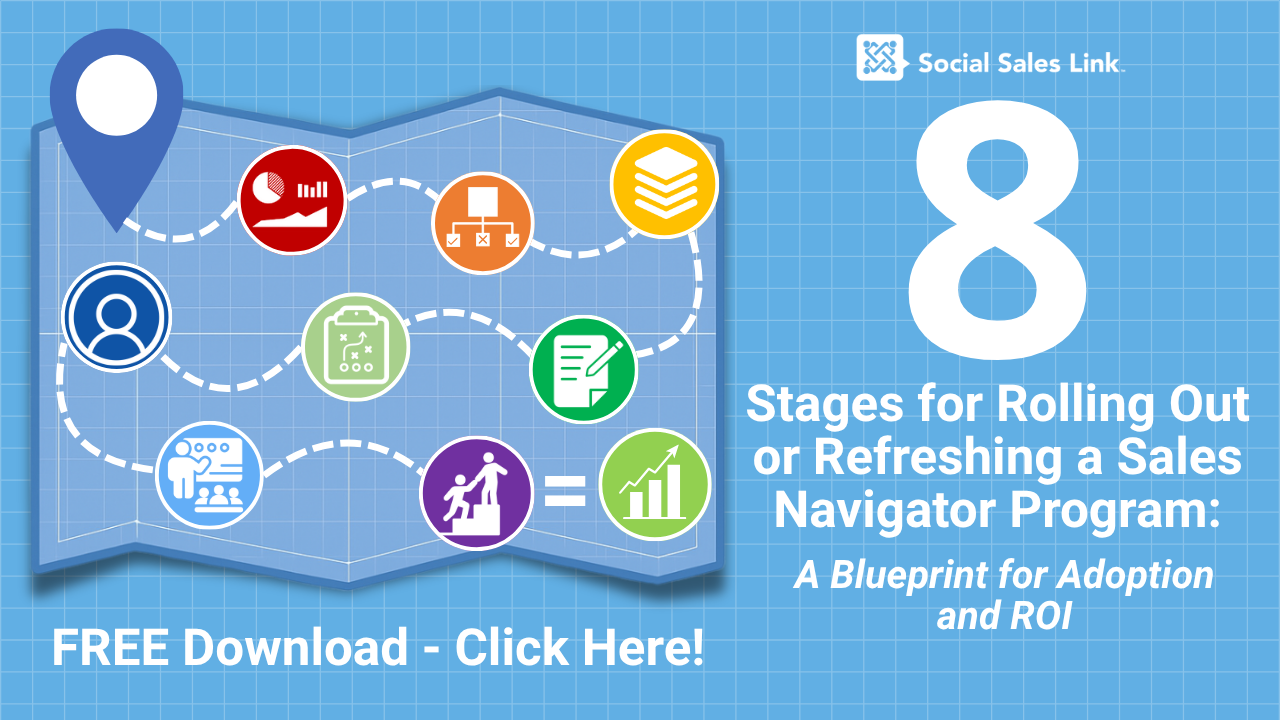The New Sales "Operating System" - Leading a Deep Sales Culture
It all starts with LinkedIn's Sales Navigator.
The TL;DR (Executive Summary)
In my mind, Deep Sales isn’t just a LinkedIn platform. It’s a mental operating system (of sorts) for how modern sales teams think, act, and connect.
Building a Deep Sales culture means going beyond adoption to alignment, mindset, and daily reinforcement.
Leadership models the behavior; teams sustain it through habits, consistency, and curiosity.
Success is measured not by how many actions you take, but by how deeply those actions resonate with buyers.
The outcome: a sales organization that operates with purpose, trust, and precision.
The Shift from Sales Process to Sales Mindset
Most teams approach Sales Navigator like a new piece of software they install but never truly integrate. The icon’s there, but it’s collecting digital dust on the desktop.
The truth is, tools don’t transform organizations. Mindsets do.
“Deep Sales” is LinkedIn’s term for a more intelligent, insight-driven approach to selling. But it’s also something deeper than data and dashboards… it’s the foundation of a modern sales culture.
When I talk about Deep Sales as a “mental operating system of sorts,” I’m describing a way of thinking that powers every decision, conversation, and connection your team makes. It’s not software that runs in the background. It’s behavior that runs in the foreground.
Deep Sales as the Mental Operating System of Modern Selling
In traditional organizations, sales teams operate in silos: prospecting, qualifying, pitching, closing. Each step happens in isolation, and sometimes is handled by different roles or people. Deep Sales, however, integrates it all.
Deep Sales isn’t about automating outreach. It’s about elevating human connection through smarter insights. It shifts the focus from “How many calls did we make?” to “How well did we understand the people we called?”
That’s a cultural shift, not a procedural one.
Leadership Sets the Tone. Culture Sustains It.
Sales culture mirrors leadership behavior. If leadership treats Deep Sales as a quarterly initiative, the team will too. But if leadership models curiosity, preparation, and authentic engagement, those behaviors become the norm.
Picture this: a VP of Sales begins each weekly pipeline meeting by reviewing buyer intent signals inside Sales Navigator. The team doesn’t just look at deal stages; they look at people signals. Who’s changed roles? Which accounts show growth or funding activity? Who’s posting on LinkedIn about a challenge your solution solves?
That’s what leading through Deep Sales looks like. It’s not micromanaging activity; it’s modeling curiosity.
Embedding Deep Sales into Everyday Habits
Deep Sales becomes culture when it becomes habit. Here’s how teams make that happen:
Pre-Call Prep: Use Sales Navigator insights before every meeting or interaction. It’s not just knowing your contact’s title, but also understanding their recent activity and shared connections.
Connection Strategy: Replace cold outreach with warm introductions, facilitated by mutual connections and shared context.
Weekly Wins: Nominate “Deep Sales Champions” who share real examples of how insights led to better conversations. Even reward them with tangible items they can use (or potentially a points/rewards system).
This transforms the sales process from a checklist into a rhythm… one built on genuine connection.
Measure the Right Metrics
If you can’t measure it, you can’t manage it. What you measure, though, matters even more. Deep Sales shifts metrics from activity to impact.
Instead of focusing on calls or emails sent, measure:
Conversations that moved forward because of shared insights.
Connections built through warm introductions.
The quality of LinkedIn engagement from target accounts.
Track culture, not just conversion.
Scaling the Deep Sales Mindset Across Teams
The most effective sales organizations don’t just “roll out” tools. They align people, systems (and tools), and purpose around a shared mindset.
That means enablement trains for curiosity, not compliance. Marketing delivers insights, not just leads. Sales managers coach conversations and interactions, not just quotas.
In a true Deep Sales culture, everyone from leadership to SDRs speaks the same language: insight, empathy, and relevance.
The Real Outcome: Human at Scale
The irony of Deep Sales is that technology, when used right, brings humanity back to sales. When your team sees every buyer as a relationship, not a record, you’re not just selling better; you’re selling more authentically.
Deep Sales is how you scale human connection without losing it.
What do you think? Should Deep Sales be a part of your team’s mental OS? Any other thoughts? Let me know in the Comments section below.
This completes my five-part series on Making Sales Navigator Work: From License to Lifeblood. We’ve covered:
Part 1 - Why LinkedIn’s Sales Navigator Fails (and How Leaders Can Fix It)
Part 2 - The ROI of Consistency: It’s Sales Navigator, Plus...
Part 3 - How LinkedIn’s Sales Navigator Helps You Sell Like a Human
Part 4 - Embedding LinkedIn’s Sales Navigator Into Your Team’s Workflow
Part 5 - The New Sales “Operating System” - Leading a Deep Sales Culture (this article)
Hope you got real value from it. If there’s something else you’d like me to cover, please let me know in the Comments section as well.
NOTE: The hero image for this article was generated by AI.
Want to turn Deep Sales from a philosophy into a framework?
Our free eBook, The 8 Stages for Rolling Out a Sales Navigator Program, shows you how to move beyond adoption into cultural transformation… step by step.




